Lectures/Classes 2014
February 7, 2014 by admin
Filed under Garden Lectures
Wednesday, February 12
When: 9:30 am
Where: John Jay Homestead, 400 Jay St., Katonah, NY
Monthly meeting of the Bedford (NY) Garden Club
Lecture: Shade Revealed: How to Garden Successfully in Low Light (Really!)
Thank you to the Bedford Garden Club for hosting this event.
Thursday, February 13 (snow date February 20)
When: 1:15 pm
Where: St. Luke’s Church, 49 Turkey Hill Rd. North, Westport, CT
Monthly meeting of the Westport (CT) Garden Club
Lecture: Shade Revealed: How to Garden Successfully in Low Light (Really!)
Thank you to the Westport Garden Club for hosting this event.
Monday, March 10
When: 1:00 pm
Where: private home, New Canaan, CT
Monthly meeting of the New Canaan (CT) Gardeners
Lecture: Shade Revealed: How to Garden Successfully in Low Light (Really!)
Thank you to the New Canaan Gardeners for hosting this event.
Friday, March 21
When: 1:45 pm
Where: Lewis B. Rome Commons, University of Connecticut campus, 626 Gilbert Rd. Extension, Storrs, CT
UConn 2014 Garden Conference
Registration required; fee charged; visit the event registration web page for more information
Lecture: Shade Revealed: How to Garden Successfully in Low Light (Really!)
Thank you to the UConn College of Agriculture and Natural Resources Extension, the Ornamental Plant Extension Team, and the Home and Garden Education Center for organizing this event.
Wednesday, April 9 (snow date April 10)
When: 5:00 pm social; 6:00 pm lecture
Where: St. Mary’s Auditorium, 43 Foreside Rd., Falmouth, ME
Great Gardener Series fundraiser for St. Mary’s Garden Club
Tickets: $16 in advance; $20 at the door; visit the event web page for directions and more information
Lecture: Cottage Gardening: Adapting a Classic Garden Style to the Northeast
Thank you to the St. Mary’s Garden Club for hosting this event.
Saturday, April 12
When: 10:00 am
Where: White Flower Farm, 167 Litchfield Rd. (Rte. 63), Morris, CT
Registration fee: $15; advance registration requested. See the event registration web page for details
Lecture: Shade Revealed: How to Garden Successfully in Low Light (Really!)
Thank you to White Flower Farm for hosting this event.
Wednesday, May 14
When: 10:00 am
Where: Waveny House, 677 South Ave., New Canaan, CT
Monthly meeting of the New Canaan Garden Club
Lecture: Containers that Won’t Quit
Thank you to the New Canaan Garden Club for hosting this event.
How (Not) to Pick a Plant
February 6, 2014 by admin
Filed under Garden Design, Perennials, Shade Gardening
Over the coming months I’ll be basing a number of blog posts, including this one, on material from my forthcoming book, The Shady Lady’s Guide to Northeast Shade Gardening. The official publication date is May 6, 2014. You can learn more about the book here, here and here.
When you pick perennial plants to put in your shade garden, how do you do it? Most people would start out by picking plants they like—and that’s where they’d make their first, and worst, mistake.
Huh? What? Surely I can’t be advising you to pick out plants you don’t like?! No, of course not. But think about this for a second. When you go shopping for a new car, do you just pick out the one you like the best? No—at least not if you’re like most of us. If that were all it took, we’d all be driving around in Ferraris and Lamborghinis. The problem with that approach is that most sports cars won’t do what most people need a car to do: get up a snowy hill on a winter day and deliver you to your job in one piece, or get enough miles to the gallon to not break the fuel budget.
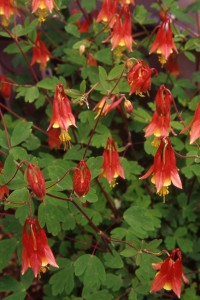
Flowers, flowers, we all like flowers—but there are many other important things to consider when choosing shade perennials.
In other words, we consider practical things. As weird an idea as this will seem to many people, you should do the same thing when you pick out plants—if you want your garden to look good with minimal effort and expense for the longest possible season.
Not all plants are equally good at doing that. In fact, for any given type of garden in any given region, only a small number of plants will give that kind of superior performance, in the same way that, in all likelihood, only a small number of cars will satisfy your criteria for budget and functionality.
So, what are the practical questions you have to ask when picking out plants? First, the more obvious ones:
• Is the plant cold hardy where I live?
• Does the plant prefer the conditions I can offer it?
It’s self-evident why these are questions you should ask first. It makes little sense to populate your perennial garden with plants that won’t be, well, perennial in your area. It also makes little sense to invest in plants that won’t be happy with the growing conditions you provide them. Matching plants to growing conditions is an essential part of the art of garden design. I’m not going to go into detail here about the fine points of that process; what matters is that you realize its importance.
What else do you need to ask yourself in order to pick the best perennials for shade? Here are a few more:
• Is the plant disease resistant?
• Is the plant prone to insect infestation?
• Is the plant unpalatable to deer and other potential browsers?
• Does the plant spread or seed aggressively?
• Does the plant typically go dormant before first frost?
• Does the plant have foliage that looks good all season long?
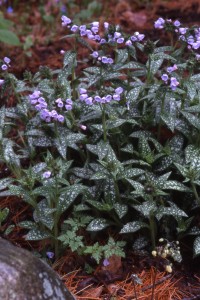
Powdery-mildew resistant Pulmonaria 'Roy Davidson'
The benefits of disease and pest resistance are obvious. Lungworts (Pulmonaria, see photo at left), for example, have unique speckled foliage that can brighten shady nooks and crannies, but most of them are prone to a disfiguring fungal disease called powdery mildew that leaves them coated with an unattractive whitish film. Luckily, some lungworts are resistant. If you buy only the resistant ones, you’ll be able to enjoy the beauty of disease-free lungworts, and you won’t have to expend extra effort to keep them that way.
It’s the same story for all the other questions above. By carefully selecting plants that aren’t palatable to most insect pests and browsing animals, you eliminate the need to take action to stop various critters from nibbling. Likewise, you reduce the need for work (and increase the percentage of your time in the garden devoted to enjoying it) by avoiding overly aggressive spreading plants.
Finally, as a general rule plants that perform well over a long season should be given priority over those that go dormant early or whose foliage declines in quality after flowering. Obviously, we’d all prefer a garden that looks full and good for the longest possible stretch of time.
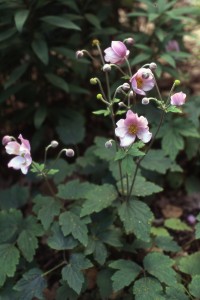
The long-flowering Japanese anemone cultivar 'Robustissima'
• Does the plant have attractive, prominent flowers? (Finally!)
• Do the flowers have a scent that’s nice, objectionable or simply absent?
• Do the flowers last a long time?
And there you have it: questions about flowers are in last place. Now, I want to clarify something. I understand perfectly why so many home gardeners give in to the temptation to fill their properties with plants having beautiful flowers. Beautiful flowers are lovely to look at—it’s as simple as that. The problem is that we don’t live in an ideal world. Flowers fade, and most perennials only produce flowers for two to three weeks every year under the best of circumstances. That’s not very long, so if you pick plants based on how well you like their flowers, you won’t get much bang for your buck.
I’m not saying that you should ignore a plant’s flowers when making choices. For instance, it is true that a small number of perennials will flower for a longer-than-average time, and can be worthwhile making room for these plants in your garden for that simple reason. One example is the Japanese anemone pictured above. I’m just saying that most of the time you should only be considering the flowers of plants that have passed muster in a lot of other ways first. Flowers should be your last consideration, not your first.
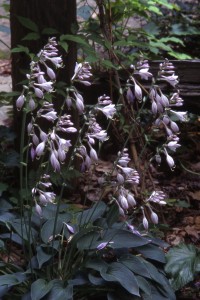
Cut these hosta flowers off? Not me!
In my next blog post, I’ll elaborate a little more on what makes a superior shade perennial and share a few examples.
My New Shade Gardening Book!
February 6, 2014 by admin
Filed under My New Book
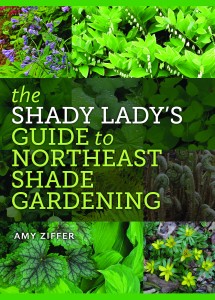 I am happy and proud to announce that my new book, The Shady Lady’s Guide to Northeast Shade Gardening from the University Press of New England is now available at bookstores and is shipping from online retailers!
I am happy and proud to announce that my new book, The Shady Lady’s Guide to Northeast Shade Gardening from the University Press of New England is now available at bookstores and is shipping from online retailers!
If you own a copy and are looking for the supplemental photos promised in the book, you can view the first batch (for Plants for Special Situations, beginning on page 189), by clicking here. Photos of Selected Shrubs (corresponding to text beginning on page 31) are on view here.
In the near future, in response to reader requests, I’ll also be adding a gallery of wider context garden shots to illustrate some of the shade garden design pointers I give.
I’d like to say a heartfelt “thanks” to readers who have posted favorable reviews in cyberspace, as well as to these respected folks, who read the book in the pre-print stage and had some kind words:
“Gardens—and gardeners—are rooted in place, so it’s a good idea to let people know where you’re coming from when you offer advice. Amy Ziffer’s The Shady Lady’s Guide to Northeast Shade Gardening puts it right out front. Hers is no one-size-fits-all tome, but a friendly and informative guide for gardeners who deal with trees, deer and unpredictable weather of the Northeast. Practical, detailed and realistic, Ziffer engagingly conveys the challenges and rewards garnered from years of hands-on gardening and close observation. Her depth of experience and conversational tone make this book the next best thing to being in the garden with her.”
—Karen Bussolini, garden author, photographer, speaker and eco-friendly garden coach
“Every Northeastern gardener needs to read this eyes-wide-open, tell-it-like-it-is book. Even if you don’t have shade now, follow the advice in this book and sections of your garden might someday bask in the shadows of luxuriant bedfellows. Get enlightened.”
—Tovah Martin, author of The Unexpected Houseplant and The New Terrarium.
“If you are tired of watching your lawn fade in the shady areas of your property, or have decided to fill those bare spots under your oak with beautiful perennials, Amy Ziffer can help. In her timely new book, the Shady Lady challenges a common misconception in gardening: that there are very few perennials that thrive in the shade. For gardeners seeking a nondestructive compromise between all native landscapes and those decorated only with exotic ornamentals, The Shady Lady’s Guide to Northeast Shade Gardening is a must read.”
—Douglas W. Tallamy, author of Bringing Nature Home: How You Can Sustain Wildlife with Native Plants.
I wrote the book because I saw a need for a different kind of book about ornamental shade gardening. While much good material has been written about the subject through the years, I saw the existing body of advice as incomplete.
What makes this book different from ones you’ve seen before? First, it’s specifically for gardeners in the Northeast. Because weather, growing conditions, and plant pests and diseases vary so much from region to region, you’ll find the best, most accurate gardening advice close to home. My book talks only about plants we Northeast gardeners can grow, organized to help you narrow down your choices even further by USDA Zone and growing situation.
Second, it takes a unique approach to plant selection and design. I’ve been frustrated by shade gardening books that simply list plants as if all of them were equally good. They’re not. My book evaluates plants based on their performance potential over the whole growing season as well as in specific light levels and under different growing conditions. They’re categorized to help you quickly find the plants most likely to contribute to a rewarding, successful landscape design for your unique property.
I introduce a concept I’ve used in my own design work for years: backbone plants. This is my own term for a select group of plants whose ornamental qualities are so superior to those of the bulk of plants that they should comprise the majority of most shade garden designs. By devoting most of your garden space to backbone plants, you’ll simplify the process of design and increase the chances of having a satisfying garden enormously.
Third, it discusses gardening honestly and frankly, as an endeavor that requires a real commitment of time and energy and has a real ecological impact—potentially good or bad. I strongly encourage increased use of the many fine native plants that have the potential to be superior shade garden performers. Conversely, I warn readers about the possible negative effects of using overly aggressive exotic plants they might one day wish they’d never grown. It’s my hope the book will stimulate a respectful dialogue—one that’s already going on—about whether and how we gardeners should leave a mark on our surroundings.
Thanks for your interest in my book! Here are links to a variety of resources where you can find out more about it and purchase it online (but please don’t forget about your hometown bookseller):
My Author page at the University Press of New England’s website.
My Facebook Author page. Please “Like” my page to help me promote it!
Indigo (Canada)
Plants for Shade Containers
May 28, 2012 by admin
Filed under Container Gardening, Shade Gardening
A year ago I blogged about the subject of my Containers that Won’t Quit lecture, which is how to compose containers that will look as good in September as they do in June. That prompted a request for a post recommending great shade tolerant plants for containers. In my area, Memorial Day weekend is when it’s considered “safe” (reliably free from frost) to plant annuals and tender perennials, so it’s often when people plant their containers. In light of that, here are some recommendations—annual and otherwise—for your shade containers.
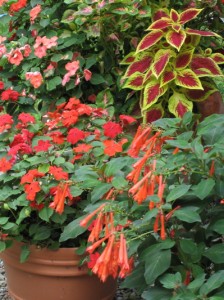
Color-coordinated fuchsia, gold-margined coleus and impatiens in containers
Your options for attractive compositions will expand considerably if you’re willing to use plenty of colorful foliage and not restrict yourself to flowering plants. Interestingly, many of the best plants for this purpose are things you might already know as houseplants or hardy perennials.
Second, a rule of thumb: In shade, gold rules. That is, no color shows up in the shadows better than gold—not even white. Creeping Jenny (Lysimachia nummularia ‘Aurea’) is a fast-growing plant whose long stems bearing bright, penny-shaped leaves will trail beautifully over the sides of containers. It’s sold as an annual in garden centers in spring, but it’s actually a perennial supposedly hardy to USDA Zone 3, and I can say for sure it’s hardy here in Zone 5. I’d also try cultivars of the perennial grass Hakonechloa macra, which has a lax, compact and clumping habit. ‘Aureola’ and ‘All Gold’ are two choices that will give you a bright splash of virtual sunshine to light up shady spaces.
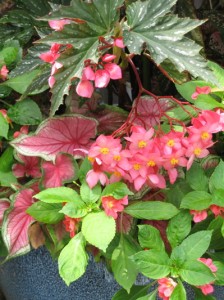
Fancy begonia, caladium and Fusion impatiens make a shade portrait in pink
Five wonderful houseplants for container use are asparagus fern (Asparagus densiflorus, usually ‘Sprengeri’), Southern maidenhair fern (Adiantum capillus-veneris), polka-dot plant (Hypoestes), peace lily (Spathiphyllum) and Schefflera. The first two will add a feathery, delicate texture to your container combinations, while I often use the last two as solitary specimens filling an entire container on their own.
Peace lily is one of the very best performng plants for very low light situations because it has attractive, glossy, lance-shaped leaves in profusion and it produces showy white flowers continuously. Schefflera comes in a gold-variegated form made all the more attractive by the fact that no two leaves have the same coloration. As an added benefit, both can be overwintered easily in a bright spot indoors and then returned to outdoor containers year after year. The lovely Southern maidenhair fern, in contrast, needs such high humidity during the winter months that I simply discard it in fall and buy new in spring.
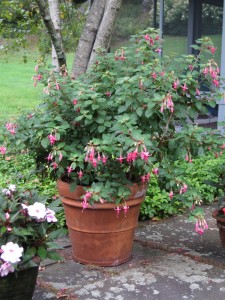
Three Fuchsia 'Mrs. J.D. Fredericks' fill a pot beautifully on their own
In light shade, and still considering foliage plants, try tropicals such as Alocasia and Colocasia. Depending on the selection, both have the potential to get quite large, so generally speaking these will be choices for larger containers. They’ll give you a lushness that will stand out in a northern landscape.
For a similarly tropical look but a naturally more compact habit, you can’t beat Caladium and Syngonium. Few people seem to know the latter plant, which is a caladium lookalike, but it’s usually sold as a houseplant. The most common form has mottled, apple green leaves with a fresh appearance. Caladiums can range from the fairly subtle to the almost garish. ‘Candidum’ types have a tasteful, green-and-white simplicity, while others are heavily splashed with bright red and pink. (Click here to see a number of containers featuring several of the tropicals mentioned above.)
And of course I can’t neglect to mention coleus (Solenostemon). In the north, most coleus actually need brighter conditions than their reputation suggests, but they’re great plants for spots with morning sun or bright but indirect light. Some of my favorites are ‘Kingswood Torch’, ‘Festive Dance’ and ‘Butter Cream’.
The selection of flowering plants that will bloom all summer in northern shade is slim. For lighter shade, you can get away with fuchsias (I recommend two upright types: orange ‘Gartenmeister Bonstedt’ and pink ‘Mrs. J.D. Fredericks’—see above) and trailing wishbone flower (Torenia). The Summer Wave series of torenias will produce a waterfall of flowers in shades of purple, blue, rose and even pale yellow.
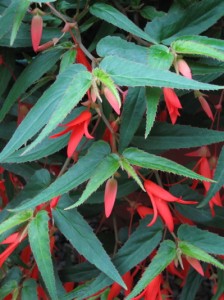
Begonia boliviensis 'Bonfire' trails to produce cascades of brilliant flowers
I mentioned that many perennials also make great container plants, with the added benefit of being able to overwinter them in the ground outdoors and then replant them in your containers in spring. You might even find that they overwinter in your containers just fine, eliminating that extra step.
Virtually any hardy fern that’s the right size and shape for your container would be an excellent choice for shade. Hostas, too, are a good choice no matter the size of your container because there are hostas ranging from miniatures to monsters.
The drapey dead nettles (Lamium) such as ‘White Nancy’ will provide both flowers on and off throughout the summer and good frosty foliage.
Finally, many selections of the perennial Heuchera (coral bells) have been introduced in the past few years with mouthwateringly beautiful foliage. Tantalizingly, selections in the Dolce series are all named after foods! ‘Key Lime Pie’, ‘Peach Melba’ and ‘Blackcurrant’ will spice up your shade containers with colors to rival those of any flowers.
Alight with White: Native Flowering Trees to Brighten Spring Days
April 14, 2012 by admin
Filed under Native Plants, Spring Bloomers
It’s spring in southern New England! With deciduous trees still bare and most of the understory just waking up, the landscape remains largely brown and grey. But in a few short weeks, wherever there are trees, there’ll be shade. White flowers show up beautifully against both backgrounds, which may explain why so many of our native trees and shrubs have them.
We all know and love the flowering dogwood that’s so emblematic of our eastern woodlands, but in this post I’d like to sing the praises of two lesser known trees with white flowers that can make equally admirable additions to the landscape.
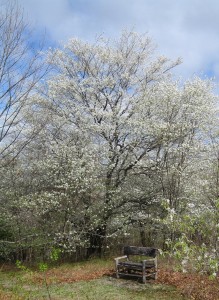
A tree-form shad in its April glory.
The shads (also called shadbush, shadblow, juneberry or serviceberry) are a rather taxonomically confused group of trees and shrubs, but don’t let that put you off. All shads are members of the genus Amelanchier. A. arborea is the largest, a tree that can rival a star magnolia in size and shape if given enough sun and good soil. A. canadensis and A. laevis are both smaller, more willowy, and usually multi-trunked. There are also hybrid crosses between these species, as well as shrubs forms native to both the East and West Coasts (A. stolonifera and A. lamarckii, respectively).
The tree forms are grown more as ornamental landscape plants, while the shrub forms are grown either for fruit or for naturalizing, since they tend to sucker. All of them have delicate flowers, borne when the plants are still leafless, that look like a bunch of short white streamers flying in the wind. In early summer they produce fruits the size and color of wild blueberries. These come and go in the blink of an eye because they are a favorite bird food, so bird lovers take note.
They are said to make great people food, too, but I’ve never cultivated them for their fruit and I suspect that humans who try might need to fence them to keep the birds from making off with everything.
To top things off, shads also offer good fall foliage, with yellows and oranges predominating.
In practice, shads for sale in nurseries aren’t always labeled with tremendous accuracy, so don’t rely too heavily on that. You just want to make sure you’ve bought a tree form if you want a tree, and a shrub form if you want a shrub. Plant all of them at the woodland edge just as you would a dogwood, and they’ll light up grey April days.

The unusual tassel-like flowers of fringe tree.
Chionanthus leafs out significantly later than most other woody plants, which has made more than one client call me in mid May to say, “I think we lost the fringe tree this winter,” but I have yet to see one die in the landscape if planted well. Buy the plant in flower if you can; plants are either male or female, and males have showier blossoms.
Both shad and fringe tree will do fine planted in loamy soil with average moisture and good drainage, although both can tolerate less than this ideal. Shads can be grown from the Canadian border and even points further north down through the Carolinas and into parts of Georgia. Fringe tree is cold hardy at least to Zone 5, but supposedly occurs naturally as far south as the Gulf of Mexico.
Lucky for me, they both do well in southern New England, where I love them as low care woodies that seem to capture and hold light in the garden in their season.
Lectures/Classes 2012
November 10, 2011 by admin
Filed under Garden Lectures
The next best thing to gardening is talking about gardening, and I would love to speak to your group! I offer a wide range of presentations for a variety of audiences. Please check my Lectures page for details, and use this Contact form to make further inquiries. You can also visit my listing at the GreatGardenSpeakers.com website, where you’ll find a wealth of details. Here’s my current schedule of upcoming lectures. I hope to see you at one of them!
Tuesday, March 6
When: 11:00 am
Where: Connecticut Valley Garden Club meeting; members and guests only
Lecture: Shade Revealed: How to Garden Successfully in Low Light (Really!)
Thank you to the Connecticut Valley Garden Club for hosting this event.
Saturday, March 10
When: 2:00 pm
Where: Woodbury Public Library, 269 Main St. South, Woodbury, CT
Phone: (203) 263-3502
Lecture: Containers that Won’t Quit
Thank you to the Woodbury Public Library for hosting this event.
Wednesday, March 14
When: 1:00 pm
Where: Sherman Garden Club meeting; members and guests only
Lecture: A Connecticut Cottage Garden: Adapting a Classic Garden Style to New England
Thank you to the Sherman (CT) Garden Club for hosting this event.
Tuesday, March 27
When: 9:15 AM
Where: Fairfield History Museum, 370 Beach Road, Fairfield, CT
Lecture: A Connecticut Cottage Garden: Adapting a Classic Garden Style to New England
Thank you to the Fairfield Garden Club for hosting this event.
Wednesday, March 28
When: 7:00 pm
Where: Caudatowa Garden Club meeting and fundraiser, Ridgefield Community Center, 316 Main St., Ridgefield, CT
Lecture: Shade Revealed: How to Garden Successfully in Low Light (Really!)
Thank you to the Caudatowa Garden Club for hosting this event.
Wednesday, April 4
When: 7:00 pm (tentative)
Where: Wallingford Public Library, 200 North Main St., Wallingford, CT
Phone: (203) 265-6754
Lecture: A Connecticut Cottage Garden: Adapting a Classic Garden Style to New England
Thank you to the Wallingford Public Library for hosting this event.
Tuesday, April 10
When: 10:00 AM
Where: Greenwich Green Fingers Garden Club meeting; members and guests only
Lecture: Shade Revealed: How to Garden Successfully in Low Light (Really!)
Thank you to the Greenwich Green Fingers Garden Club for hosting this event.
Wednesday, April 11
When: 7:00 pm
Where: South Windsor Public Library, 1550 Sullivan Ave., South Windsor, CT
Lecture: A Connecticut Cottage Garden: Adapting a Classic Garden Style to New England
Thank you to the Down to Earth Garden Club for hosting this event.
Tuesday, April 17
When: 6:30 pm
Where: Bethel Public Library, 189 Greenwood Ave., Bethel, CT
Phone: (203) 794-8756
Lecture: A Connecticut Cottage Garden: Adapting a Classic Garden Style to New England
Thank you to the Bethel Public Library for hosting this event.
Wednesday, April 25
When: 1:00 pm
Where: Garden Club of Nyack (NY) meeting; members and guests only
Lecture: A Connecticut Cottage Garden: Adapting a Classic Garden Style to New England
Thank you to the Garden Club of Nyack for hosting this event.
Saturday, May 5
When: TBD
Where: Trumbull Public Library/Fairchild Nichols Branch, 1718 Huntington Tpke., Trumbull, CT
Phone: (203) 452-5196
Lecture: Containers that Won’t Quit
Thank you to the Trumbull Public Library for hosting this event.
Monday, June 4
When: TBD
Where: Larchmont Avenue Church (The Carhart Room), 60 Forest Park Ave., Larchmont, NY
Lecture: Shade Revealed: How to Garden Successfully in Low Light (Really!)
Thank you to the Garden Club of Larchmont for hosting this event.
Objets of My Desire: Garden Ornaments
March 11, 2011 by admin
Filed under Garden Decor
Most gardeners start out as plant addicts, and that’s a shoe that fits squarely on my foot. But as the years have gone by, I’ve come to appreciate that gardens are about a lot more than plants. They are about a whole gestalt, something greater than the sum of its parts. The best gardens are an outgrowth of their creator, reflecting many facets of the gardener’s life and aesthetic.

This armillary sphere is the centerpiece of a whole garden
But truth be told, plants have a limited ability to express so much, especially here in the North where many of them vanish from sight for months out of the year. That’s why I subscribe to the idea that no ornamental garden is complete without some, well, ornament.
By virtue of the contrast they make with their living surroundings, inanimate objects draw attention to themselves in the garden. They can mark a crossing, an edge, or the end of a long vista, reinforcing the geometry of a layout. They can be eye candy for a visitor resting on a bench or in a gazebo. A truly stunning objet might be the centerpiece of the whole garden, the thing that all the plants are there to adorn.
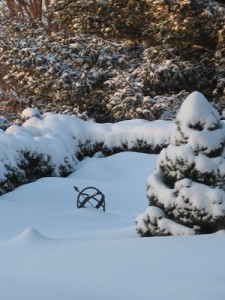
In winter, the ornament is also a point of orientation
Whatever the size and style of your garden, it would probably benefit from some artfully positioned sculpture, bench, bird bath, fountain or urn. (Click on these terms to see some online sources with particularly good or particularly large selections.)
The month of March, before winter completely leaves us for its annual hiatus, seemed like a particularly apt time to reflect on how garden ornaments can contribute to the year-round interest of outdoor spaces.
In a town a few miles from me, there’s a particularly beautiful garden that’s in its prime. Its owners truly love their landscape, and the same extremely talented gardener has tended it for 25 years. This concentration of energy and time shows everywhere you look. I photographed this garden throughout 2010. On some recent trips there to capture it with snow’s decorative accent, I was struck by how strong an impact was made by a few small ornaments that could safely be left outside through the winter months.
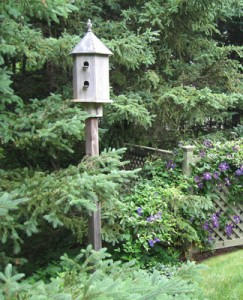
This birdhouse enlivens a dark background
Whereas pottery generally has to be protected from very low temperatures, metal and wood are materials that can withstand freezing without much damage. In cold climates, most of us enjoy our winter gardens through the window, from the warmth of our houses. Spots in the garden that are viewed from oft-frequented places—a kitchen window where you stand to do dishes, for instance—can benefit especially from ornaments that remain in place year round.
The property I photographed has just such a spot. Windows in some heavily used rooms overlook a beautiful, geometric herb garden whose centerpiece is a metal armillary sphere. On the winter day I visited, precious little of the garden’s geometry was evident—it was covered in several feet of snow. But there was the tenacious armillary sphere! Snow had drifted all around it, obscuring other features of the space, but it stalwartly marked what I knew to be the center of the garden, like a sentinel seeming to promise that it was looking out for things until better weather arrived.
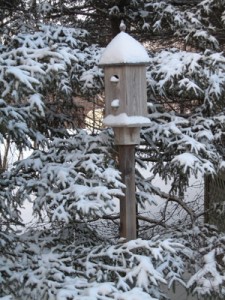
A birdhouse in winter anticipates the return and reawakening of life
Similarly, I was charmed by the way a dusting of fresh snow lay on a birdhouse that’s positioned at the end of a view down the length of the house. It marks a boundary, enlivening what would otherwise be a rather dark, featureless screen of tall evergreens. Sitting on a pole about six feet high, it had no trouble keeping its head above the snow level, even in this record-breakingly snowy winter.
In the photos here, you can see what both of these ornaments look like in summer and winter. You’ll just have to take my word for it that they made all the difference in the memorability of the snow-gripped landscape.
When you venture out into your own garden this spring, think about what sort of ornament delights you and where an objet of your desire might go to complete some garden vignette. I’ll bet that round about this time next year you’ll be glad you did!
Celebrating Small Flowers
February 6, 2011 by admin
Filed under In the News, Plant Rant
This post marks the first time my blog also appears in the Christian Science Monitor online. Their Diggin’ It feature is a great place to read the thoughts and opinions of garden bloggers from around the country, and I hope to contribute on a regular basis.
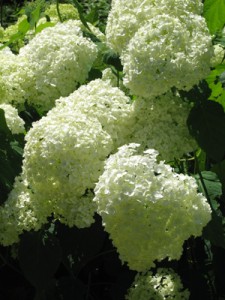
Hydrangea 'Annabelle' is a bit too, well, buxom
For as long as people have been growing plants for beauty instead of utility, plant breeders have had an obsession with developing ever bigger flowers. Within reason, that’s understandable. Sometimes, there’s no harm in having a little more of something you like (I’m thinking blueberry pie). But there comes a point with any good thing at which more is just too much.
Today, nurseries are full of plants with flowers so enormous and weighty they literally can’t hold themselves up. I mean, if Hydrangea arborescens ‘Annabelle’ were a person, she’d be a candidate for breast reduction surgery on grounds of medical necessity.
Plant breeders aren’t the only ones to blame, of course. Someone had to buy all those oversized horticultural wonders. I’m not pointing fingers, but you know who you are. (And I admit that I’m one of them, although I’m recovering.)
Well, I’m here today to celebrate the (sometime) superiority of small flowers.
Consider the peony. Nearly every Paeonia lactiflora (the common herbaceous peony—the plant most people think of when you say “peony”) you can find at a retail nursery will have gigantic bombe-type flowers. They’re upwards of six inches across and fully double with hundreds of petals. When open, they weigh so much that their stalks will bend or break, leaving the flowers in the dust, as a result of a decent rain or a good gust of wind. In other words, all it takes is some normal weather to cause them to collapse.
Peony hoops really aren’t much help. They just cause the stalks to bend and break above the level of the hoop, as opposed to lower down. Staking methods that attempt to solve this problem, such as a circle of chicken wire, are (in my opinion) ugly and time-consuming. I’m looking more for “attractive and easy” gardening methods, or better yet, “do nothing at all” methods.
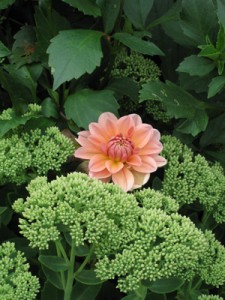
My "Goldilocks" dahlia—just the right size
I just don’t understand why people put themselves through this when, by growing single peonies, they could avoid the problem altogether. Take a look at these beautiful single peonies from Hidden Springs Flower Farm. At most, these plants need a single hoop encircling the whole clump just to hold them upright in case of some really severe weather.
Dahlias are pretty much the same story. Certain dark forces in the world of horticulture would have you believe that so-called “dinner plate” dahlias are the most desirable and obviously worth their premium price. You’ll never catch me buying them, though. My favorite dahlia is this unidentified orange one pictured at left that a client in my garden design business shared with me many years ago. Its flowers are about three inches across and perfect for flower arrangements because they’re in scale with black-eyed Susans and other perennials that flower in mid to late summer when the dahlia does. I see similar ones in catalogs all the time…usually at a cheaper price than their overgrown relatives. Yes, the plant as a whole requires a great big tomato cage, but the individual stems are perfectly capable of holding up the flowers without additional support.
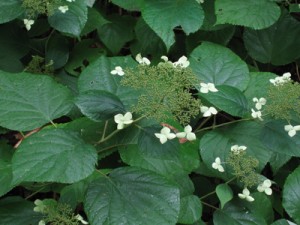
Hydrangea arborescens ssp. radiata holds up its head in all kinds of weather
I mentioned Hydrangea arborescens ‘Annabelle’ already. I still grow her, but she is a handful. I’d much prefer a cultivar with flowers about half the size, but wishing doesn’t make it so. (I’m not the only one. Read blogger Tim Wood’s extensive ramblings about hydrangeas here.) One alternative is to grow the species or its subspecies, H. a. ssp. radiata, both of which produce lacecap floral displays instead of foot-wide snowballs. (There are many other lacecap types, but they won’t bloom reliably in Zones 5 and colder.) These choices won’t fall to pieces after a summer downpour.
My message here is that bigger is not necessarily better. Supersize flowers can come with supersize maintenance requirements. That doesn’t make them bad…just more work. As the old saying goes, “the bigger they are, the harder they fall,” and that’s enough of a reason for me to celebrate small flowers.
Containers that Won’t Quit
January 22, 2011 by admin
Filed under Container Gardening
All too often, advice about container gardening seems to come in the form of some kind of “design challenge” in which container gardens are judged based on a photograph taken at a single point in time. This sort of thing has its place, but most of us aren’t planting containers to enter in the equivalent of a flower show exhibit. We’re planting them with the intention of beautifying some space for the entire growing season. Here in the North, that means June, July, August and hopefully beyond. That’s a different sort of challenge altogether.
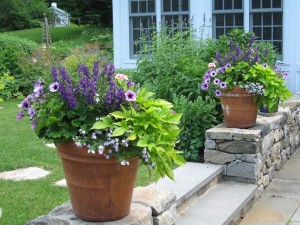
A classic container combination looking fresh in June...
What’s more, it seems like too many of the “design challenge” winners feature things like Hardtofindium breakthebankium as a centerpiece. That’s my name for a plant that was discovered growing on a scree slope in the Himalayas just last year and can only be procured at midnight during a lunar eclipse at a remote location from a shady character who requires a ransom payment and a secret code word. (Didn’t think horticulture was so Hollywood, did you?)
Okay, I’m exaggerating a little bit, but really—how many of us have the time and money to track down obscure plants from specialty growers? I’m not disparaging either one (plants or growers), but the majority of gardeners just don’t garden that way. They put together their containers using what they find at the nearest good nursery.
It’s because of the shortcomings of the “design challenge” sort of articles and TV segments that have become so widespread that I recently created a new talk entitled “Containers that Won’t Quit.”* It’s all about how to plant containers that will look as good in September as they do in June using common, easy to procure materials. Take a look at the pair of photographs above left and below right, and you’ll see what I mean.
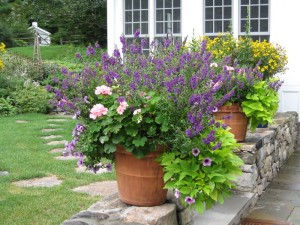
...and just as beautiful in September!
For a container to look good all season long, its flowers can’t peter out in the heat of summer, and there has to be an easy way to keep its components in proportion as they grow. It goes without saying that the plants in the container have to remain healthy, so I place a premium on plants that are naturally disease resistant.
These requirements all lead to a particular approach to container gardening based on using a “short list” of the best plants, learning how to imagine at planting time how the container will look when it’s developed, following a few basic design tips, and performing some easy, routine maintenance to keep everything at its best.
The containers in the photos above were planted for a client who once told me, “This will sound kind of boring, but I really just like petunias and geraniums.” So I planted the exceptional purple Supertunia ‘Bordeaux’ (one of the top two or three petunias you can buy, in my opinion) with pink geraniums, blue Bacopa, ‘Sweet Caroline’ sweet potato vine (Ipomoea), and a purple angelonia. The combination is simple, inexpensive, classic, and absolutely stunning all summer long. The only care it requires (above and beyond the obvious watering and fertilizing) is deadheading the geraniums weekly, cutting the petunias and the sweet potato vine back two or three times during the summer, and occasionally clipping out spent angelonia stems to encourage branching. That’s about as easy as a container gets.
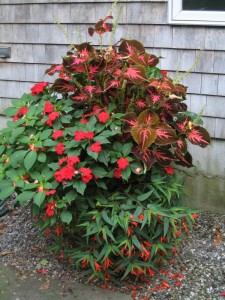
A long-lasting hot color combo for moderate shade
Consider the container pictured at left. It’s one of my favorites from the past few years. What’s in it? Certainly nothing exotic: coleus, impatiens and begonia. That’s it! What makes it work so well is using superior selections of these common plants. The coleus at the rear is ‘Kingswood Torch’, which grows into an impressive plant with just a couple hours of sunlight each day, as well as the Fusion series impatiens (‘Infrared’, in this case) interplanted with the old-fashioned, been-around-forever red Super Elfin Impatiens x walleriana from 6-packs, and ‘Bonfire’, a type of Begonia boliviensis that has made its way into the trade in the last few years. This begonia is quite disease resistant, has a graceful trailing habit, and (as you can see) is super-floriferous.
Want to keep things even simpler? You can’t get any easier than a container with just one kind of plant. In sun, my first choice would be Calibrachoa (sometimes called by the common name “million bells”). These petunia relatives, with flowers that look like miniature versions of their cousins, are possibly the single best trailing flowering plants around. For hanging baskets, they’re unsurpassed. Combine a couple of them in complementary colors, and you’ve got a smashing container. Or, add a simple companion like Euphorbia ‘Diamond Frost’ (shown below with Calibrachoa ‘Crackling Fire’) for a little contrast.
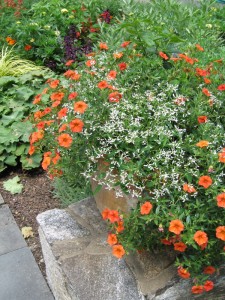
A super simple container that stands up to heat
In shade, one of the very best plants capable of filling a container on its own and flowering all season long is Spathiphyllum, often called “peace lily.” You’ll usually find it in the greenhouse at your local nursery because it’s grown as a houseplant. You’ll pay $25-30 for a good-sized specimen, but it’s a plant you’ll be able to overwinter easily (it’s just dirt simple to care for) and return to your shade containers outside year after year after year, so it’s a great long-term investment.
I’ll be writing more about designing containers in future blog posts, but I’ll mention one important concept now: echoing color and shape. Of course, you’re free to plant a container that’s an absolute circus of colors and shapes if that’s what you want. But most people seem to agree that having some kind of relationship between the plants in a container is most satisfying to the eye. Two or more plants that feature similar colors or shapes in either their flowers or leaves harmonize, whereas totally dissimilar plants are much less likely to make an appealing combination. One caveat, though: you don’t want the plants to be too similar or the effect won’t be nearly as attractive.
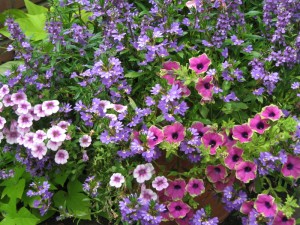
Echoing flower colors and shapes
The combination of Calibrachoa Superbells ‘Tickled Pink’ and Petunia Supertunia ‘Pretty Much Picasso’ (along with purple Scaevola) shown at left illustrates both ideas. The flowers of both plants have a flared bell shape, while the light pink of one blends beautifully with the hot pink of the other even as the two remain distinct. Additionally, the chartreuse margin of the petunia flowers picks up the bright green leaves of ‘Sweet Caroline’ sweet potato vine at far left.
If you haven’t always been happy with your container gardens, consider my Containers that Won’t Quit approach. I’ll be writing more about it down the line, so don’t forget to subscribe. And if you’d like to have me give the full story about Containers that Won’t Quit to your garden club or other group, please drop me a line using this Contact form to let me know of your interest. Until then, may your winter be restful and restorative and a time to learn new ideas for the coming gardening season!
Have you got a photograph of your own favorite Container that Won’t Quit combination? Be sure to label everything as fully as you can and describe why you like it so much. Then send it along and I’ll post it for other readers to see.
* I just had the pleasure of debuting Containers that Won’t Quit for the Taconic Gardeners Club in Chappaqua, NY, and I’d like to thank the club for the opportunity. Before and after the talk I enjoyed chatting with several members about plants, containers, garden photography and more, and I can say that they’re a great group. If you’re located in the lower Hudson Valley, southwest Connecticut or even New York City, they’d love to have you as a member and I know you’d enjoy knowing them. Please take a look at their website and consider joining.
8 Great Plants for a Late Season Show
October 5, 2010 by admin
Filed under Autumn, Autumn Bloomers, Seasons in the Garden
It’s an accepted truth in the retail nursery industry that most customers only buy plants when they’re in full bloom. It’s not hard to guess, then, why many gardens are lacking in late-season plants. By August, gardeners are a little tuckered out and less likely to visit nurseries, so they never get to know all the wonderful plants that are at their best from September onward.
There are so many impressive late-season garden performers, in fact, that I had trouble whittling the list down to just eight. In the end, it was a bit of a coin toss, and I opted to focus more on plants that are less common or have exceptionally long “peak” periods. The runners-up include the old reliable and ubiquitous black-eyed Susan (Rudbeckia), the late flowering bugbanes such as Cimicifuga ‘Hillside Black Beauty’ (not the native C. racemosa, which starts and finishes flowering earlier), and the native asters (two of which I profiled here).
All of these plants require plenty of sun and well-drained soil, with the exception of turtlehead, which can tolerate light shade and a moist spot in the garden.
As a general design rule of thumb, I like to group plants that peak at the same time near one another in the garden rather than space them out too much. A combination I like a lot starts with a tall pink New England or New York aster such as ‘Alma Potschke’ at the rear. In front of that put a few specimens of burgundy-leaved snakeroot (Eupatorium rugosum ‘Chocolate’—see below). Finally, add Northern sea oats (Chasmanthium latifolium—again, see below) in the foreground. The aster will get “bare legs” as the season progresses, as pretty much all tall asters do, but they’ll be hidden by the bushy foliage of the snakeroot. A pink aster, meanwhile, will bring out the deep purple tones of the snakeroot’s foliage. At the front, the heavy, showy seedheads of the ornamental oats will arch gracefully, dance in the slightest breeze, and slowly turn from green to russet as autumn progresses. With a little thought, I’m sure you’ll find many wonderful combinations using these 8 great late-season plants.
 Japanese anemone
Japanese anemone
Anemone x hybrida ‘Robustissima’
All of the Japanese anemones are good performers, but I recommend ‘Robustissima’ for the North because of its exceptional hardiness. This plant is late to emerge in spring but quickly produces a dense 2-3’ tall clump of grape leaf-shaped foliage. In August, delicate, naked stems spring up another foot, topped by poetically fragile, shell pink flowers. Although it can be aggressive in some gardens, it’s generally not a problem plant. Spraying with deer repellant is essential since it’s a favorite of the hooved crowd.
 Northern sea oats
Northern sea oats
Chasmanthium latifolium
It’s a mystery to me why this medium-sized, self-supporting, very showy and native grass isn’t more common in our gardens! It looks great next to just about any companion, mixes well with small shrubs such as spireas, and its seed heads are long lasting when harvested and dried for arrangements. Grows 2.5-3’ high and 2’ wide.
 Turtlehead
Turtlehead
Chelone
The two species of turtlehead native to North America and occasionally used in gardens bloom white or pale pink in the wild, but the much more brightly colored cultivar ‘Hot Lips’ is what you’re more likely to find for sale at nurseries. Turtlehead is notable for its extremely long flowering period and robust, healthy foliage. If grown in shade, it can be lax, but in sun I’ve found it to be entirely self-supporting and a nearly no-care plant for the front of the border.
 Dahlia
Dahlia
Dahlia
Dahlias, of course, aren’t cold hardy in New England, but of all the common tender tubers and bulbs, it’s the most rewarding. It’s often thought of as just a fall-blooming plant, but that doesn’t have to be so. I put dahlias in the ground around the second week of May. They generally break ground in late May, just when the threat of frost is passing. If you plant them this way, you’ll have flowers starting in July, and they’ll keep going until hard frost, making dahlias one of the longest blooming plants available. I avoid dahlias with enormous flowers because their stems are prone to breakage from the excessive weight they have to bear. Provide tall dahlias with support, and to successfully overwinter them, pack them in ever-so-slightly damp light soil or another medium (nearly anything, from sphagnum moss to wood shavings, will do) and store them at 40 degrees F in a container that is not completely airtight. I’ve overwintered them in everything from damp basements to dry, heated sheds; they seem less sensitive to humidity than temperature—they do not want to get warm! With a little luck, dahlias can last for many, many years.
 Chrysanthemum or Mum
Chrysanthemum or Mum
Dendranthema
A mum by any other name is still a mum…but these days, it’s more likely to be called Dendranthema. Unless you go out of your way to find unusual varieties, the ones you’re most likely to see are apricot-pink ‘Sheffield’ or its lookalike, ‘Cambodian Queen’. Both are bone hardy and medium sized, making them suitable for most New England gardens. Mums, like asters, get “bare legs” and should be planted behind something lower growing and bushy to look their best. They’ll be dense and less likely to flop if you pinch them once or twice by removing a third of their growth before mid July.
 Hardy ageratum
Hardy ageratum
Eupatorium coelestinum, syn. Conoclinium coelestinum
If you’re a lover of blue flowers, you’ll want this. Its stems won’t elongate until well after other plants have put on lots of growth, but be patient—it will become bushy once it gets going, growing 2’ tall and indefinitely wide via a dense mat of spreading roots. Regular division is essential! Its exceptional flower color echoes that of Lobelia siphilitica and Caryopteris x clandonensis.
 Snakeroot
Snakeroot
Eupatorium rugosum, syn. Ageratina altissima
This New England native plant is so dirt common you may have dozens of them growing on your property without even knowing it, but you’ll be amazed at what a bushy, showy plant it becomes when you move it away from the woodland edges where it naturally finds its niche and give it the space and sunlight of a perennial border. Its sprays of small white flowers attract a wide variety of nectar feeders. Although the cultivar ‘Chocolate’ (referring to its burgundy leaves) is more commonly offered for sale in nurseries, the plain green-leaved roadside species is equally beautiful.
 Fountain grass
Fountain grass
Pennisetum alopecuroides
Here’s a second moderately sized, self-supporting grass with showy seedheads and absolutely minimal maintenance needs. It’s common in commercial plantings, but home gardeners often ignore it in favor of larger, harder to manage grasses. Fountain grass is the perfect companion for any Sedum spectabile, such as ‘Autumn Joy’. Its mophead shape makes it a natural choice for the “first tier” of the perennial border, where its delicate blades can drape gracefully over the edge between border and path.

